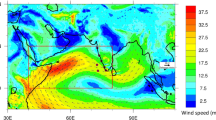Abstract
Using the NCEP/NCAR reanalysis wind and temperature data (1948–2011) and India Meteorological Department (IMD) rainfall data, a long-term trend in the tropical easterly jet stream and its effect on Indian summer monsoon rainfall has been explained in the present study. A decreasing trend in zonal wind speed at 100 mb (maximum decrease), 150 mb, and 200 mb (minimum) is observed. The upper-level (100, 150, and 200 mb) zonal wind speed has been correlated with the surface air temperature anomaly index (ATAI) in the month of May, which is taken as the difference in temperature anomaly over land (22.5°N–27.5°N, 80°E–90°E) and Ocean (5°S–0°S, 75°E–85°E). Significant high correlation is observed between May ATAI and tropical easterly jet stream (TEJ) which suggests that the decreasing land–sea temperature contrast could be one major reason behind the decreasing trend in TEJ. The analysis of spatial distribution of rainfall over India shows a decreasing trend in rainfall over Jammu and Kashmir, Arunachal Pradesh, central Indian region, and western coast of India. Increasing trend in rainfall is observed over south peninsular and northeastern part of India. From the spatial correlation analysis of zonal wind with gridded rainfall, it is observed that the correlation of rainfall is found to be high with the TEJ speed over the regions where the decreasing trend in rainfall is observed. Similarly, from the analysis of spatial correlation between rainfall and May ATAI, positive spatial correlation is observed between May ATAI and summer monsoon rainfall over the regions such as south peninsular India where the rainfall trend is positive, and negative correlation is observed over the places such as Jammu and Kashmir where negative rainfall trend is observed. The decreased land–sea temperature contrast in the pre-monsoon month could be one major reason behind the decreased trend in TEJ as well as the observed spatial variation in the summer monsoon rainfall trend. Thus, the study explained the long-term trend in TEJ and its relation with May month temperature over the Indian Ocean and land region and its effect on the trend and spatial distribution of Indian summer monsoon rainfall.







Similar content being viewed by others
References
Bansod SD, Singh HN, Patil SD, Singh N (2012) Recent changes in the circulation parameters and their association with Indian summer monsoon rainfall. J Atmos Sol Terr Phys 77:248–253
Chen TC, Van Loon H (1987) Interannual variation of the tropical easterly jet. Mon Wea Rev 115:1739–1759
Chen TC, Yen MC (1991) Intraseasonal variations of the tropical easterly jet during the 1979 northern summer. Tellus, Ser A 43:213–225
Kalnay E et al (1996) The NCEP/NCAR reanalysis projects. Bull Am Meteor Soc 7:437–471
Kobayashi N (1974) Interannual variations of tropical easterly jet stream and rainfall in South Asia. Geophys Mag 37:123–134
Koteswaram P (1958) Easterly jet stream in the tropics. Tellus 10:43–57
Pattanaik DR, Satyan V (2000) Fluctuations of tropical easterly jet during contrasting monsoon over India: a GCM study. Meteorol Atmos Phys 75:51–60
Rajeevan M, Jyothi B, Kale JD, Lal B (2006) Development of a high resolution daily gridded rainfall data for Indian region. National Climate Centre, IMD, Pune
Rao BRS, Rao DVB, Rao VB (2004) Decreasing trend in the strength of tropical easterly jet during the Asian summer monsoon season and the number of tropical cyclonic systems over Bay of Bengal. Geophys Res Lett 31, L14103. doi:10.1029/2004GL019817
Rao VB, Ferreira CC, Franchito SH, Ramakrishna SSVS (2008) In a changing climate weakening tropical easterly jet induces more violent tropical storms over the north Indian Ocean. Geophys Res Lett 35, L15710. doi:10.1029/2008GL034729
Sathiyamoorthy V (2005) Large scale reduction in the size of the tropical easterly jet. Geophys Res Lett 32, L14802. doi:10.1029/2005GL022956
Sathiyamoorthy VP, Pal K, Joshi PC (2007) Intraseasonal variability of the tropical easterly jet. Meteorol Atmos Phys 96:305–316
Sharon EN, Jeremy PG (2003) The seasonal evolution of the atmospheric circulation over West Africa and Equatorial Africa. J Clim 16:1013–1029
Author information
Authors and Affiliations
Corresponding author
Rights and permissions
About this article
Cite this article
Sreekala, P.P., Bhaskara Rao, S.V., Arunachalam, M.S. et al. A study on the decreasing trend in tropical easterly jet stream (TEJ) and its impact on Indian summer monsoon rainfall. Theor Appl Climatol 118, 107–114 (2014). https://doi.org/10.1007/s00704-013-1049-z
Received:
Accepted:
Published:
Issue Date:
DOI: https://doi.org/10.1007/s00704-013-1049-z




